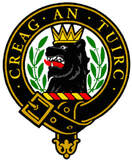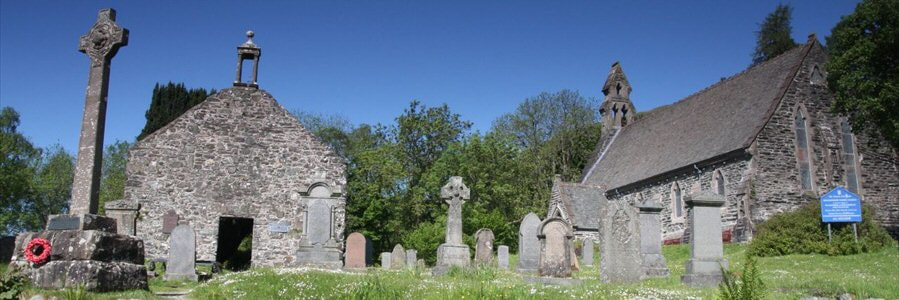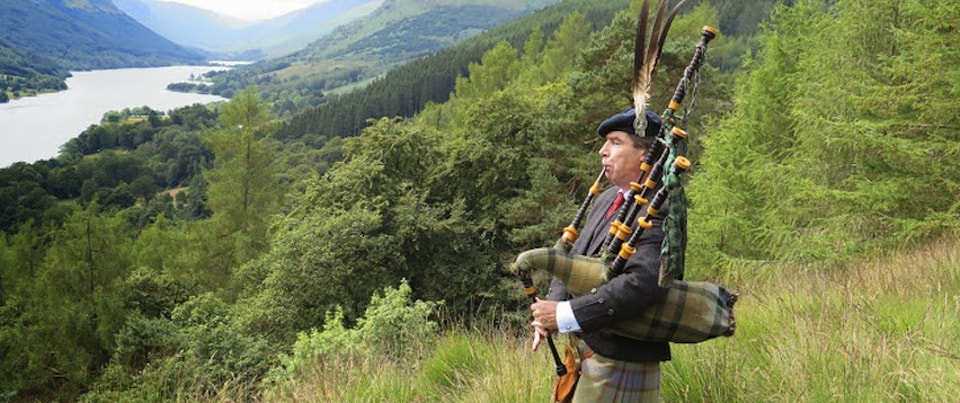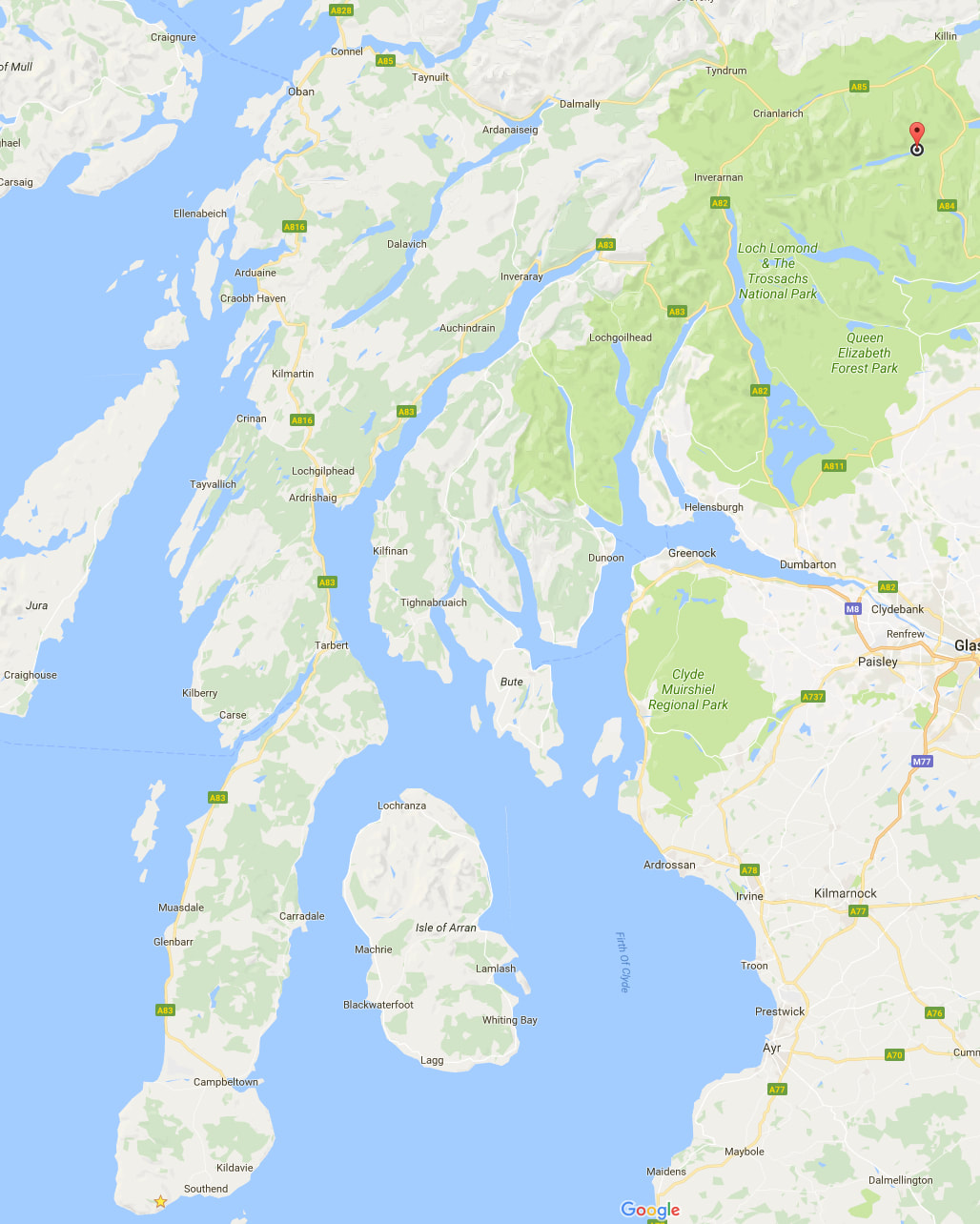Clan McLaran Chieftain, Donald McLaren, at Creag An Tuirc, Balquhidder
Source: The Clan McLaren Society
Source: The Clan McLaren Society
Clan McLaren and Ancient Origins

Balquhidder is acknowledged as the Clan McLaren ancestral homeland, however, the family of McLeorans /McLarans who are the subject of this website were all born and raised around Southend in Argyllshire for many generations prior to emigration.
Southend history suggests it is highly unlikely there is a connection between the Southend McLeorans and Clan McLaren of Balquhidder. Refer Scottish Roots page.
Southend history suggests it is highly unlikely there is a connection between the Southend McLeorans and Clan McLaren of Balquhidder. Refer Scottish Roots page.
Clan McLaren Society North America provides this excellent summary of Clan history:
Clan MacLaren has, along with MacGregor, Ferguson, and MacNab, occupied the lands in Balquhidder and Strathearn since the 12th Century, where they were the predominant clan.The name derived from Labhran (Laurin) of Ardveche who was hereditary Abbot of Achtus in Balquhidder in the 13th Century. The MacLarens signed the Ragman's Roll in 1296. In the 14th Century they became Crown tenants without actual ownership of the land.
The MacLarens were a warlike clan with strong ties to the Stewarts of Appin. The Clan fought at Flodden in 1513, and suffered severely at Culloden with the Jacobites, on the side of Bonnie Prince Charlie, in 1746. Sir Walter Scott visited Balquhidder on legal business, which he describes in the introduction to "Rob Roy". In "Redgauntlet" he describes the escape of MacLaren of Invernenty after Culloden.
In 1672, after many official records were lost, an Act of Parliament ordained that all nobility and gentry in Scotland register their armorial bearings with the Lord Lyon. Because of the earlier loss of the legal title to Clan lands, the then chiefly head of the Clan Labhran, and his successors, did not trouble to register his arms. The result was that the Clan became officially chiefless and landless pending compliance with the Act. Of course the Clan continued to recognize its own chiefs, and during the Jacobite rising came out as a Clan.
In 1957, Donald MacLaren (father of the current Chief) finally complied with the Act by recording the ancient Arms in the Lord Lyon Register. The Chief also acquired title to a small part of the traditional Clan lands including the ancient gathering site of Creag an Tuirc) and the stigma of "chiefless and landless" was removed.
The heartland of the Clan MacLaren lies in and around the parish of Balquhidder, and the hills that slope north from Loch Voil and Loch Doine, which are known as the famous Braes o' Balquhidder. The parish is 18 miles long and 7 miles wide, and includes the west end of Loch Earn and most of Loch Lubnaig.
The ruined Kirk of the village is dated 1631, and lies near the site of an even earlier church. The present church was built in 1855. Graves in the kirk yard date from 1685 and include that of Rob Roy MacGregor. The ancient rallying place of the Clan was Creag an Tuirc (The Boar's Rock), which is on a small hill overlooking the Kirk, and can be approached by a fairly steep path. In 1987 the Clan Society erected a cairn to commemorate the founding of the Society.
Clan MacLaren has, along with MacGregor, Ferguson, and MacNab, occupied the lands in Balquhidder and Strathearn since the 12th Century, where they were the predominant clan.The name derived from Labhran (Laurin) of Ardveche who was hereditary Abbot of Achtus in Balquhidder in the 13th Century. The MacLarens signed the Ragman's Roll in 1296. In the 14th Century they became Crown tenants without actual ownership of the land.
The MacLarens were a warlike clan with strong ties to the Stewarts of Appin. The Clan fought at Flodden in 1513, and suffered severely at Culloden with the Jacobites, on the side of Bonnie Prince Charlie, in 1746. Sir Walter Scott visited Balquhidder on legal business, which he describes in the introduction to "Rob Roy". In "Redgauntlet" he describes the escape of MacLaren of Invernenty after Culloden.
In 1672, after many official records were lost, an Act of Parliament ordained that all nobility and gentry in Scotland register their armorial bearings with the Lord Lyon. Because of the earlier loss of the legal title to Clan lands, the then chiefly head of the Clan Labhran, and his successors, did not trouble to register his arms. The result was that the Clan became officially chiefless and landless pending compliance with the Act. Of course the Clan continued to recognize its own chiefs, and during the Jacobite rising came out as a Clan.
In 1957, Donald MacLaren (father of the current Chief) finally complied with the Act by recording the ancient Arms in the Lord Lyon Register. The Chief also acquired title to a small part of the traditional Clan lands including the ancient gathering site of Creag an Tuirc) and the stigma of "chiefless and landless" was removed.
The heartland of the Clan MacLaren lies in and around the parish of Balquhidder, and the hills that slope north from Loch Voil and Loch Doine, which are known as the famous Braes o' Balquhidder. The parish is 18 miles long and 7 miles wide, and includes the west end of Loch Earn and most of Loch Lubnaig.
The ruined Kirk of the village is dated 1631, and lies near the site of an even earlier church. The present church was built in 1855. Graves in the kirk yard date from 1685 and include that of Rob Roy MacGregor. The ancient rallying place of the Clan was Creag an Tuirc (The Boar's Rock), which is on a small hill overlooking the Kirk, and can be approached by a fairly steep path. In 1987 the Clan Society erected a cairn to commemorate the founding of the Society.
Scotweb has a more detailed history of Clan MacLaren
Scotweb says:
Origins of the clan
The origins of the clan are uncertain but by tradition the MacLarens are descended from a man called Lorn who was the son of Erc who landed in Argyll in 503 A.D. However there is no concrete evidence of Lorn being the progenitor of the family.
A more likely origin of the clan is that they are of Celtic stock and take their name from a 13th century abbot called Laurance of Achtow. This theory is also supported by the MacLaren rallying cry which in gaelic is: “Creag an Tuirc” which means “Boars Rock”. The rock in question is near Achtow in Balquhidder. The Clan MacLaren’s lands are in Perthshire.
Scotweb says:
Origins of the clan
The origins of the clan are uncertain but by tradition the MacLarens are descended from a man called Lorn who was the son of Erc who landed in Argyll in 503 A.D. However there is no concrete evidence of Lorn being the progenitor of the family.
A more likely origin of the clan is that they are of Celtic stock and take their name from a 13th century abbot called Laurance of Achtow. This theory is also supported by the MacLaren rallying cry which in gaelic is: “Creag an Tuirc” which means “Boars Rock”. The rock in question is near Achtow in Balquhidder. The Clan MacLaren’s lands are in Perthshire.
Part map of Scotland: Balquhidder (red marker, top right) and Southend and Feorlan (yellow star, bottom left).

Balquhidder church and graveyard
Clan McLaren tartans.
Comment
Is there a way that a connection between the descendants of Malcolm McLaran and Clan McLaren can be confirmed or ruled out?
Yes there is: the Clan McLaren Society of North America www.clanmaclarenna.org offers Clan DNA testing for male descendants of an unbroken male line. A test of a direct male-line descendant of Malcolm McLaran would cement the heritage of the family, one way or the other.
Is there a way that a connection between the descendants of Malcolm McLaran and Clan McLaren can be confirmed or ruled out?
Yes there is: the Clan McLaren Society of North America www.clanmaclarenna.org offers Clan DNA testing for male descendants of an unbroken male line. A test of a direct male-line descendant of Malcolm McLaran would cement the heritage of the family, one way or the other.


